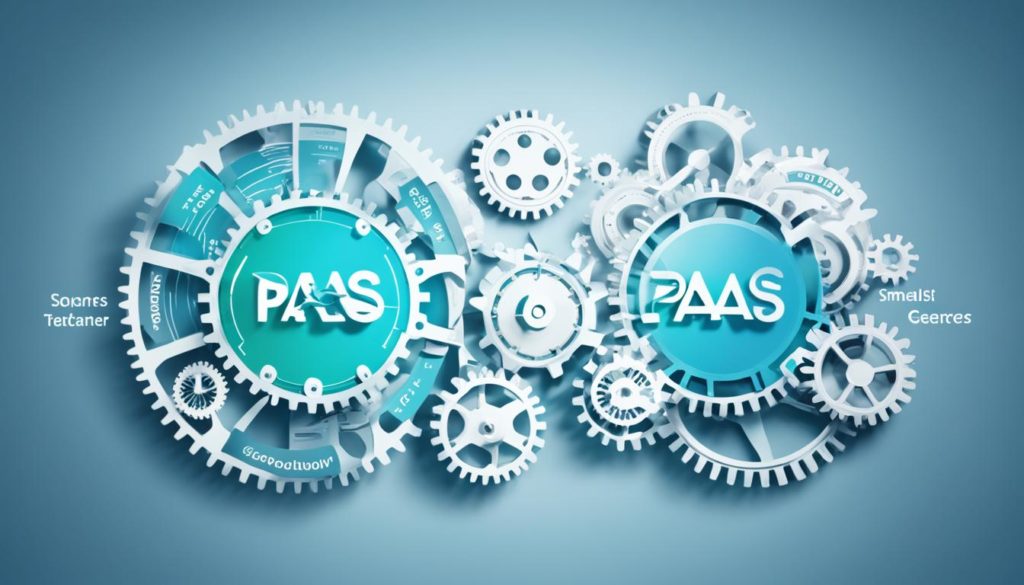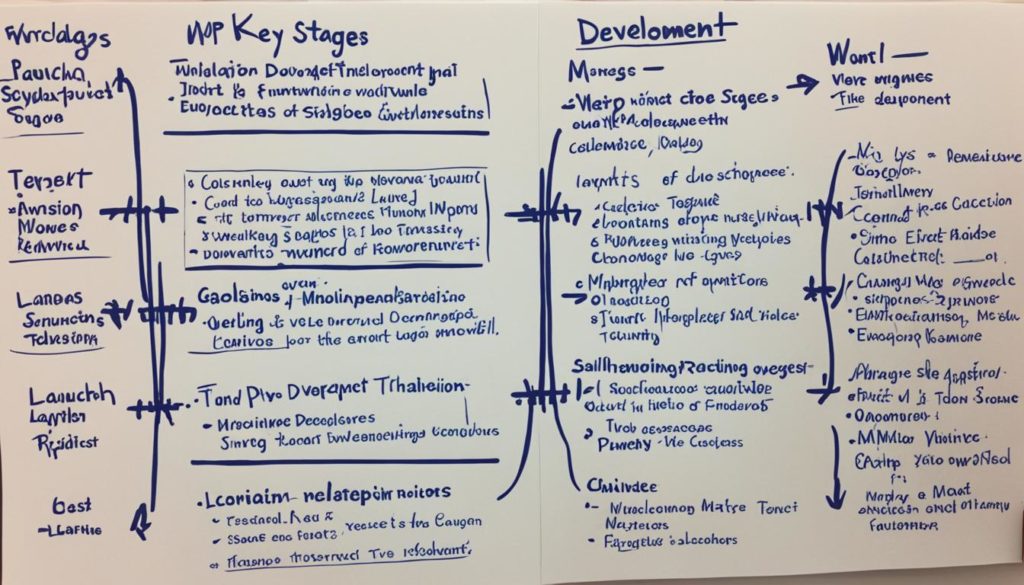
The global Platform as a Service (PaaS) market is booming. By 2026, it’s expected to soar to over $164.3 billion. We’re diving into the world of cloud computing to see how PaaS is sparking this growth. PaaS has changed how we develop applications by offering many options that encourage innovation and reduce complexity.
We’re here to examine the strong points of PaaS that shape today’s coding world. PaaS frees developers from managing infrastructure. It gives them powerful tools through the internet. Let’s see how these features help in making app creation, testing, and management smoother and more efficient.
Key Takeaways
- Current and projected scale of the PaaS market underscores significant growth within cloud computing.
- In-depth exploration of how PaaS advantages streamline application development and deployment.
- Insight into the array of Platform as a Service Features that companies can leverage today.
- Understanding of how PaaS capabilities foster innovation without the complexity of infrastructure management.
- An overview of the varied PaaS options available to developers for optimizing the software lifecycle.
Understanding the Essence of Platform as a Service (PaaS)
Exploring Platform as a Service shows its key role in cloud computing. It offers big benefits and security for businesses of all sizes. This is true from small startups to large companies.
What is Platform as a Service?
Platform as a Service is a main part of cloud computing. It provides powerful tools over the internet. With PaaS, businesses don’t worry about the hardware below.
It makes creating apps easier and faster. This boosts innovation and efficiency.
Core Characteristics of PaaS Solutions
PaaS stands out with its helpful features for teamwork and web integration. It is made to manage business growth and different workloads. PaaS is great for being both agile and secure.
The Evolution of PaaS Over the Years
PaaS has grown from hosting apps to offering full development spaces. This change led to hybrid PaaS. It combines public and private services for specific needs.
Also, CPaaS and MPaaS show PaaS’s flexibility. They allow for special apps in communication and mobile management. This happens with little coding.
To sum up, PaaS has made it easier, safer, and more efficient to develop apps. Leading PaaS providers keep making it better. As tech gets better, PaaS stays focused on improving development and business speed.
Essential Platform as a Service Features
Platform as a Service, or PaaS, gives businesses essential tools for app development and deployment. It offers PaaS functionalities that boost productivity and spark innovation. This is crucial in many sectors today.
At its core, PaaS features a full development stack. It combines operating systems, middleware, and creation tools. This mix makes building and managing apps easier, reducing the need for heavy coding.
PaaS is great for creating apps that work on many platforms. This is key in a world where mobile and web need to be seamless across devices. Its support for mobile app development, or mPaaS, lets developers manage mobile apps easily. This is perfect for businesses wanting to grow their mobile game fast.
- Integrated Development Environments (IDEs) simplify code creation, testing, and deployment.
- Automated scaling adjust resources as needed, ensuring top performance effortlessly.
- Advanced analytics tools offer insight into app usage and help in making decisions.
PaaS also brings tools specific to certain fields like Communications PaaS (CPaaS). CPaaS adds real-time communication in apps without huge infrastructure costs. Open PaaS, an open-source option, helps with collaboration and innovation through web apps.
For those focusing on security, Private PaaS answers with tailored, secure solutions. Hybrid PaaS mixes public cloud cost efficiencies with core compliance needs. This flexibility is key for businesses.
PaaS opens new doors for businesses to refine app development and keep innovating with tech changes. The vast features it offers help sustain growth and tech progress. It’s a powerful aid in today’s tech landscape.
In summary, the wide range of PaaS functionalities boosts a company’s performance in today’s dynamic business world. It shows how crucial PaaS is in cloud computing services.
Comparating PaaS Providers: Unique Offerings and Capabilities
Exploring Platform as a Service Features shows the unique strengths of different providers. Looking at AWS Elastic Beanstalk, Engine Yard, and Google App Engine, we see varied PaaS advantages. Each provider has something special for both developers and enterprises.
AWS Elastic Beanstalk: Versatility in Language Support and Scaling
AWS Elastic Beanstalk shines with broad programming language support. It covers Java, .NET, PHP, and more. Its ability to scale based on traffic is a big PaaS advantage. You can learn about its scaling here.
Engine Yard: Specialized DevOps Management
Engine Yard is great for Ruby on Rails and supports other languages too. It eases the application deployment process. This makes it ideal for smooth cloud hosting.
Google App Engine: Embracing Serverless Architectures
Google App Engine uses a serverless approach to free businesses from infrastructure worries. It supports many programming languages. This meets the need for scalable and efficient development in the PaaS world.
if entails further expansion
| Provider | Languages Supported | Special Features |
|---|---|---|
| AWS Elastic Beanstalk | Java, .NET, PHP, Node.js, Python, Ruby, Go, Docker | Auto-scaling, Application Health Monitoring |
| Engine Yard | Ruby, Node.js, Python, PHP, Java | Advanced DevOps, Environment Monitoring |
| Google App Engine | Node.js, Ruby, Java, C#, Go, Python, PHP | Serverless Architecture, Integrated Services |
These PaaS providers boost fast app development and reduce operational costs. The PaaS advantages they offer are key today.
How PaaS Enhances Application Development Efficiency
In the world of software creation, time is as valuable as money, and working efficiently is key. With Platform as a Service (PaaS) on our side, it has changed how we build apps. It offers modern tools and services that help organize our work and encourage new ideas.
PaaS Benefits for Software Developers
Both new and established companies find PaaS solutions very useful because they are flexible and powerful. It’s shown that PaaS can cut down the time needed to write code, thanks to its ready-to-use components. This lets us spend more time on creating unique features. Plus, we can grow our projects easily and keep our apps available all the time with cloud technology, boosting our efficiency and ability to respond quickly in a fast-moving market.
Collaboration and Team Integration
Nowadays, it’s common for teams to work from different parts of the world. PaaS brings these teams together, offering tools that are essential for working in unity, even from afar. This way, we can share our knowledge globally, forming a diverse team. Such a team is agile, creative, and productive, ready to tackle complex tasks.
Faster Time-to-Market with PaaS
Being quick to adapt and launch is vital for our success today. PaaS helps us move from idea to release much faster. This speed gives us an advantage, letting us serve our users promptly and outdo our rivals. PaaS not only accelerates our work but also lets us predict results and make smart, informed choices with its analytics. Its cost-effective, pay-as-you-go pricing also keeps us both financially and operationally flexible.
FAQ
What are the main features of Platform as a Service?
Platform as a Service (PaaS) offers tools for development, middleware, and application management. It includes database management, analytics, and supports many programming languages. These features help in developing, testing, and deploying apps online without dealing with infrastructure.
How do PaaS advantages improve cloud computing?
PaaS makes cloud computing simpler by providing tech tools at a high level. This helps organizations focus on app creation instead of infrastructure. It lowers the need for deep technical skills and offers development tools on a pay basis. This saves costs and boosts efficiency.
What distinguishes PaaS capabilities from other cloud service models?
PaaS is made to support the app development cycle. Unlike IaaS with its basic resources or SaaS that offers complete software, PaaS gives tools for building, testing, deploying, and managing apps. It’s focused on developers, offering pre-built components and collaborative tools.
Can you explain the core characteristics of PaaS solutions?
PaaS solutions have software components and tools for collaboration. They come with a multi-tenant architecture and can scale automatically. These features help in fast app building, developer teamwork, user management, and handling app activity loads.
How has PaaS evolved over the years?
PaaS has grown by adding better development tools and more language support. It now includes containerization and robust data solutions. Operational models now offer public, private, and hybrid clouds. This fits different needs, like following data laws.
What unique offerings does AWS Elastic Beanstalk provide?
AWS Elastic Beanstalk supports many languages like Java, .NET, and Python. It automates deployment, scaling, and manages apps easily. The auto-scaling feature adjusts resources to fit application needs perfectly.
How does Engine Yard stand out among PaaS providers?
Engine Yard is known for DevOps management and a developer-focused PaaS. It supports multiple languages and frameworks. It also allows for lots of customization and has excellent support.
What are the benefits of Google App Engine’s serverless architecture?
Google App Engine’s serverless design removes the need to handle servers. This simplifies deployment and automatically scales with traffic changes. Developers focus on coding and app development instead of managing infrastructure.
How does PaaS enhance efficiency in software development?
PaaS boosts software development efficiency by offering pre-made app components, integrated environments, and teamwork tools. This reduces coding needs and speeds up prototype and deployment. It helps launch new apps and features faster.
How does collaboration and team integration work in PaaS?
PaaS enables team collaboration through shared environments, code repositories, and CI/CD tools. These help teams worldwide to work together effectively in real-time. They share resources, code, and updates effortlessly.
What role does PaaS play in achieving a faster time-to-market?
PaaS helps achieve a faster time-to-market with its full set of development resources and managed services. Developers can concentrate on writing app code. PaaS often has automation for testing and deployment, speeding up application launches.
Future App Studios is an award-winning software development & outsourcing company. Our team of experts is ready to craft the solution your company needs.










